Bio 311d Final Exam
5.0(1)
Card Sorting
1/173
Study Analytics
Name | Mastery | Learn | Test | Matching | Spaced |
|---|
No study sessions yet.
174 Terms
1
New cards
If a cell with genome of 20 pairs of chromosomes undergoes normal __mitosis__, how many cells result, and how many chromosomes are in each of the resulting cells?
\
A. Two cells, each with 20 chromosomes
B. Two cells, each with 40 chromosomes
C. Four cells, each with 10 chromosomes
D. Four cells, each with 20 chromosomes
E. Four cells, each with 40 chromosomes
\
A. Two cells, each with 20 chromosomes
B. Two cells, each with 40 chromosomes
C. Four cells, each with 10 chromosomes
D. Four cells, each with 20 chromosomes
E. Four cells, each with 40 chromosomes
B
2
New cards
If a cell with genome of 20 pairs of chromosomes undergoes normal __meiosis__, how many cells result, and how many chromosomes are in each of the resulting cells?
A. Two cells, each with 20 chromosomes
B. Two cells, each with 40 chromosomes
C. Four cells, each with 10 chromosomes
D. Four cells, each with 20 chromosomes
E. Four cells, each with 40 chromosomes
A. Two cells, each with 20 chromosomes
B. Two cells, each with 40 chromosomes
C. Four cells, each with 10 chromosomes
D. Four cells, each with 20 chromosomes
E. Four cells, each with 40 chromosomes
D
3
New cards
In cats, the allele for short hair (H) is dominant over the allele for long hair (h). A female cat shows the short hair trait, but in previous litters she produced some long-hair offspring. If this short-hair female is now mated with a long-hair male, what fraction of their offspring is expected to have long hair?
A. 0 (none)
B. 1/4
C. 1/2
D. 3/4
E.1 (all)
A. 0 (none)
B. 1/4
C. 1/2
D. 3/4
E.1 (all)
C
4
New cards
Sickle-cell anemia is inherited as a simple recessive traits. Heterozygote carriers do not have sickle-cell anemia. Neither John nor Maria have the disease sickle cell anemia, but since it occurs in their families they have been tested and know they both are heterozygous carriers of the recessive sickle-cell allele. Draw the Punnett square and answer:
What proportion of their offspring are expected to __have sickle cell anemia__?
A. 0 (none)
B. 1/4
C. 1/2
D. 3/4
E. 1 (all)
What proportion of their offspring are expected to __have sickle cell anemia__?
A. 0 (none)
B. 1/4
C. 1/2
D. 3/4
E. 1 (all)
B
5
New cards
Sickle-cell anemia is inherited as a simple recessive traits. Heterozygote carriers do not have sickle-cell anemia. Neither John nor Maria have the disease sickle cell anemia, but since it occurs in their families they have been tested and know they both are heterozygous carriers of the recessive sickle-cell allele. \n Draw the Punnett square (**same as Q4**) and answer
What proportion of their offspring are expected to be __heterozygous carriers__ of the sickle-cell trait?
\
A. 0 (none)
B. 1/4
C. 1/2
D. 3/4
E. 1 (all)
What proportion of their offspring are expected to be __heterozygous carriers__ of the sickle-cell trait?
\
A. 0 (none)
B. 1/4
C. 1/2
D. 3/4
E. 1 (all)
C
6
New cards
Flower color alleles in snapdragons show __incomplete dominance__. When red-flowering snapdragons are crossed with white-flowering snapdragons, all the offspring are heterozygous and have pink flowers. When two pink snapdragons are crossed, what proportion of their offspring would be expected to be pink?
\
A. 0 (none)
B. 0.25
C. 0.50
D. 0.75
E. 1.0 (all)
\
A. 0 (none)
B. 0.25
C. 0.50
D. 0.75
E. 1.0 (all)
C
7
New cards
In a certain species, 2n = 60. If one diploid cell in this species undergoes meiosis, the products will be
A. 2 cells, each with 30 chromosomes
B. 2 cells, each with 60 chromosomes
C. 4 cells, each with 30 chromosomes
D. 4 cells, each with 60 chromosomes
A. 2 cells, each with 30 chromosomes
B. 2 cells, each with 60 chromosomes
C. 4 cells, each with 30 chromosomes
D. 4 cells, each with 60 chromosomes
C
8
New cards
Which of the following is __true__ about the two members of a homologous pair of chromosomes?
A. they are identical DNA molecules
B. they form the two sides of one double helix
C. they separate from one another during meiosis II.
D. they contain the same gene loci in the same order
E. two of these are true.
A. they are identical DNA molecules
B. they form the two sides of one double helix
C. they separate from one another during meiosis II.
D. they contain the same gene loci in the same order
E. two of these are true.
D
9
New cards
For a certain mouse trait, allele *D* is dominant over allele *d*. A mouse with genotype DD is mated with a mouse with genotype dd. Of their offspring ___ are expected to show trait *d*, and ___ are expected to be heterozygous carriers of the *d* trait.
A. 50%, 50%
B. 0%, 50%
C. 0%, 100%
D. 50%, 100%
A. 50%, 50%
B. 0%, 50%
C. 0%, 100%
D. 50%, 100%
C
10
New cards
When a chestnut-colored horse is mated with a cream-colored horse, all the offspring are palomino (incomplete dominance). When two palomino horses are mated, what proportion of their offspring would be expected to be palomino?
A. 0 (none)
B. 0.25
C. 0.50
D. 0.75
E. 1.0 (all)
A. 0 (none)
B. 0.25
C. 0.50
D. 0.75
E. 1.0 (all)
C
11
New cards
In mice, short hair trait is completely dominant, and long hair is a simple recessive trait. __If__ a short-hair individual is mated with a long-hair individual and **both** long-hair and short-hair offspring result, then just from looking at the offspring you learn that:
A. the short-hair individual was homozygous
B. the short-hair individual was heterozygous
C. the long-hair individual was heterozygous.
D. more offspring are required in order to decide.
A. the short-hair individual was homozygous
B. the short-hair individual was heterozygous
C. the long-hair individual was heterozygous.
D. more offspring are required in order to decide.
B
12
New cards
Which statement about an individual that is homozygous for a specific allele is __NOT__ true?
A. Each of its body cells possesses two copies of that allele
B. Each of the gametes it produces contains one copy of that allele.
C. Both of its parents had to be homozygous for that allele.
D. It will pass that allele to all offspring.
A. Each of its body cells possesses two copies of that allele
B. Each of the gametes it produces contains one copy of that allele.
C. Both of its parents had to be homozygous for that allele.
D. It will pass that allele to all offspring.
C
13
New cards
Phenylketonuria (PKU) is a treatable metabolic disease inherited as a simple recessive trait. Jack and his wife Brittany do not have PKU, but both have a member of their extended family with PKU. When they have the genetic test, they both learn they are carriers of the PKU allele. (a) What is the probability their first child will be born with PKU, and then (b) what is the probability that if they have two children, both children will have PKU?
\
A. 1/2; 1/2
B. 1/2; 1/4
C. 1/2; 1/8
D. 1/4; 1/8
E. 1/4; 1/16
F. 1/8; 1/16
\
A. 1/2; 1/2
B. 1/2; 1/4
C. 1/2; 1/8
D. 1/4; 1/8
E. 1/4; 1/16
F. 1/8; 1/16
E
14
New cards
Classical albinism results from a particular recessive allele. Which of the following are the expected phenotypes of offspring from an albino woman and a normally pigmented man who has an albino father?
A. 3/4 normal 1/4 albino
B. 3/4 albino 1/4 normal
C. 1/2 normal 1/2 albino
D. all normal
E. all albino
A. 3/4 normal 1/4 albino
B. 3/4 albino 1/4 normal
C. 1/2 normal 1/2 albino
D. all normal
E. all albino
C
15
New cards
A woman of blood type B marries a man with blood type A. Both of them have a parent with type O blood. From the information given, determine the genotypes of the couple, draw a Punnett square, and answer what blood types (phenotypes) are possible in their children?
A. Only blood types A or B
B. Blood types A or B or O
C. Blood types A or B or AB
D. Blood types A or B or AB or O
A. Only blood types A or B
B. Blood types A or B or O
C. Blood types A or B or AB
D. Blood types A or B or AB or O
D
16
New cards
If an infant born to a mother with blood type O is also type O, possible types for the father are:
A. AB
B O or A
C. A or B
D. O only
E. O, A, or B
A. AB
B O or A
C. A or B
D. O only
E. O, A, or B
E
17
New cards
A woman with blood type A gave birth to a child with blood type AB. It is uncertain which of three men is the father of the child. Person X has blood type A, person Y has blood type O, and person Z, has blood type B.
Can one or more of these men (X, Y, Z) be *eliminated* as the father of the child based on ABO blood group data?
A. only Person X can be eliminated
B. only Person Y can be eliminated
C. only Person Z can be eliminated
D. Persons X and Y can be eliminated
E. Persons X and Z can be eliminated
F. Persons Y and Z can be eliminated
Can one or more of these men (X, Y, Z) be *eliminated* as the father of the child based on ABO blood group data?
A. only Person X can be eliminated
B. only Person Y can be eliminated
C. only Person Z can be eliminated
D. Persons X and Y can be eliminated
E. Persons X and Z can be eliminated
F. Persons Y and Z can be eliminated
D
18
New cards
A woman is heterozygous for the recessive X-linked gene for hemophilia. Her husband is not affected by hemophilia. What are the parent genotypes (with X and Y chromosomes) Draw the Punnett Square for this mating. What proportion of their sons will have hemophilia?
A. 0 (none)
B. 1/4
C. 1/2
D 3/4
E. 1 (all)
A. 0 (none)
B. 1/4
C. 1/2
D 3/4
E. 1 (all)
C
19
New cards
Very few protein-coding genes are on the Y chromosomes. **Y-linked genes** include the *sry* gene that expresses the testis-differentiation protein. A male with this gene will
A. usually pass it to his sons, but about 10% of the time also to a daughter
B. only pass the gene to his sons
C. only pass the gene to his daughters
D. only pass the gene to his grandsons, not sons
E. pass the gene to all of his children if the mother is a carrier.
A. usually pass it to his sons, but about 10% of the time also to a daughter
B. only pass the gene to his sons
C. only pass the gene to his daughters
D. only pass the gene to his grandsons, not sons
E. pass the gene to all of his children if the mother is a carrier.
B
20
New cards
Identical twin girls (same genotype) could express an X-linked trait differently in different cells if
A. they experienced different new mutations in their X chromosomes
B. the trait was sometimes dominant and sometimes recessive
C. the cells had different X chromosomes inactivated
D. some cells were homozygous and others heterozygous for the trait
A. they experienced different new mutations in their X chromosomes
B. the trait was sometimes dominant and sometimes recessive
C. the cells had different X chromosomes inactivated
D. some cells were homozygous and others heterozygous for the trait
C
21
New cards
Hemochromatosis is an inherited disease caused by a recessive allele (*not* sex-linked). If a woman and her husband, who are both heterozygous carriers, have three children, what is the probability that __all three children are of normal phenotype__ (do not have hemochromatosis).
A. 0
B. 1/16
C. 1/4
D. 27/64
E. 3/4
F. 1
A. 0
B. 1/16
C. 1/4
D. 27/64
E. 3/4
F. 1
D
22
New cards
In the Hardy-Weinberg equations, which term gives the recessive allele frequency? \[notation: ^2 = squared\]
A. p
B. q
C. 2pq
D. p^2
E. q^2
A. p
B. q
C. 2pq
D. p^2
E. q^2
B
23
New cards
In the Hardy-Weinberg equations, which of these three terms gives the homozygous recessive genotype frequency? \[notation: ^2 = squared\]
\
A. q
B. 2pq
C. q^2
\
A. q
B. 2pq
C. q^2
C
24
New cards
A gene in humans has two alleles, M and N, that are co-dominant and code for slightly different red blood cell surface proteins. If the frequency of allele M is 0.2, according to the Hardy-Weinberg equation, the frequency of the genotype MN in the population should be what?
A. 0.16
B. 0.20
C. 0.32
D. 0.40
E. 0.80
A. 0.16
B. 0.20
C. 0.32
D. 0.40
E. 0.80
C
25
New cards
\[from text, ch 21\] A fruit fly population has a gene with two alleles, A1 and A2. Tests show that 70% of the gametes produced in the population contain the A1 allele. If the population is in Hardy-Weinberg equilibrium, what proportion of the flies carry both A1 and A2? \n
A. 0.70
B. 0.49
C. 0.42
D. 0.21
A. 0.70
B. 0.49
C. 0.42
D. 0.21
C
26
New cards
In a population of mice in Hardy-Weinberg equilibrium, 4% (= 0.04) of individuals are albino (show the recessive __*a*__ trait); the rest show the dominant agouti (__*A*__). What is the frequency of agouti *A* allele?
A. 0.04
B. 0.20
C. 0.40
D. 0.80
E. 0.96
A. 0.04
B. 0.20
C. 0.40
D. 0.80
E. 0.96
D
27
New cards
In a population of fish, the frequency of the dominant allele A at a locus is 0.8. If the population has 500 individuals, what is the expected number of A alleles in the gene pool? \[Think first – how many __total__ alleles are in this gene pool?\]
A. 320
B. 400
C. 480
D. 640
E. 800
A. 320
B. 400
C. 480
D. 640
E. 800
E
28
New cards
In a beetle population in Hardy-Weinberg equilibrium there is a gene locus with a dominant allele *B* and a recessive allele *b*. 84% of the individuals in the population show the dominant trait in their phenotype (complete dominance, not sex-linked). In a sample of 100 individuals from this population, about how many individuals would be homozygous for the dominant allele? \[Think first- what percent of individuals show the recessive trait in their phenotype? What is their genotype?\]
A. 16
B. 25
C. 36
D. 50
E. 84
A. 16
B. 25
C. 36
D. 50
E. 84
C
29
New cards
The ultimate (original) origin of genetic variation is
A. genetic drift
B. natural selection
C. mutation
D. founder effect
E. non-random mating
A. genetic drift
B. natural selection
C. mutation
D. founder effect
E. non-random mating
C
30
New cards
If the frequency of alleles in a gene pool is 90% A and 10% a, what is the frequency of individuals with the genotype AA?
A. 0.90
B. 0.81
C. 0.50
D. 0.09
E. 0.01
A. 0.90
B. 0.81
C. 0.50
D. 0.09
E. 0.01
B
31
New cards
Black fur in mice (*B*) is dominant to brown fur (*b*). In a population of 100 mice, the frequency of the dominant allele is 0.6. How many mice in the population, randomly picked, are expected to have brown fur?
\
A. 16
B. 36
C. 40
D. 48
E. 50
\
A. 16
B. 36
C. 40
D. 48
E. 50
A
32
New cards
A small group of birds left their original large mainland population and started a new population isolated on an island. Several generations later, a particular color pattern is much more common in the island birds than in the mainland population, most likely due to which?
\
A. the founder effect
B. heterozygote advantage
C. mutation
D. nonrandom mating
E. gene flow
\
A. the founder effect
B. heterozygote advantage
C. mutation
D. nonrandom mating
E. gene flow
A
33
New cards
There is a large population of organisms. Ten females and two males wander off and join another large population. This is an example of:
\
A. gene flow
B. genetic drift
C. sexual selection
D. artificial selection
E. non-random mating
\
A. gene flow
B. genetic drift
C. sexual selection
D. artificial selection
E. non-random mating
A
34
New cards
The ultimate __origin__ of genetic variation is:
A. genetic drift
B. random mutation
C. natural selection
D. a founder effect
E. non-random mating
A. genetic drift
B. random mutation
C. natural selection
D. a founder effect
E. non-random mating
B
35
New cards
Which one of the following conditions would PREVENT the opportunity for *evolution by natural selection*? That is, under this condition, evolution by natural selection could not occur.
\
A. All members of the population are genetically identical
B. The environment often changes conditions.
C. Some individuals have a much higher reproductive fitness than others
\
A. All members of the population are genetically identical
B. The environment often changes conditions.
C. Some individuals have a much higher reproductive fitness than others
A
36
New cards
Natural selection changes allele frequencies because some ___ survive and reproduce better than others. \[from text end of chapter 21\]
A. alleles
B. gene loci
C. species
D. individuals
A. alleles
B. gene loci
C. species
D. individuals
D
37
New cards
Sparrows with average-sized wings survive severe storms better than those with longer or shorter wings, illustrating which of these? \[from text end of chapter 21\]
A. the bottleneck effect
B. disruptive selection
C. frequency-dependent selection
D. stabilizing selection
A. the bottleneck effect
B. disruptive selection
C. frequency-dependent selection
D. stabilizing selection
D
38
New cards
Evolution is best defined as which of the following?
A. a change in population size for a species
B. a change in living conditions for an organism
C. a change in genetic composition of a population from one day to the next day
D. a change in genetic composition of a population from generation to generation
A. a change in population size for a species
B. a change in living conditions for an organism
C. a change in genetic composition of a population from one day to the next day
D. a change in genetic composition of a population from generation to generation
D
39
New cards
What are adaptations?
\
A. inherited characteristics of organisms that enhance their survival and reproduction in specific environments
B. acquired characteristics of organisms that enhance their survival and reproduction in specific environments
C. processes that allow individuals with certain inherited traits to survive and reproduce
D. patterns seen in fossils documenting the origins of other new groups of organisms
\
A. inherited characteristics of organisms that enhance their survival and reproduction in specific environments
B. acquired characteristics of organisms that enhance their survival and reproduction in specific environments
C. processes that allow individuals with certain inherited traits to survive and reproduce
D. patterns seen in fossils documenting the origins of other new groups of organisms
A
40
New cards
In areas of Africa in which malaria is prevalent, many human populations exist in which the allele that produces sickle-cell disease and the allele for normal red blood cells occur at constant frequencies, despite the fact that sickle-cell anemia disease frequently causes death at an early age. This is an example of
A. the founder effect
B. heterozygote advantage
C. mutation
D. nonrandom mating
E. gene flow
A. the founder effect
B. heterozygote advantage
C. mutation
D. nonrandom mating
E. gene flow
B
41
New cards
Which form of __speciation__ always involves a geographic barrier that initially separates two subsets of a single population?
\
A. allopatric
B. sympatric
C. reduced hybrid fertility
D. habitat isolation.
\
A. allopatric
B. sympatric
C. reduced hybrid fertility
D. habitat isolation.
A
42
New cards
A genetic analysis of a certain species found that all individuals were homozygous at many gene loci, even for genes that were not at all important to survival, so any variation there would have been neutral (zero selection). The most likely explanation is a history of
A. large population size
B. high rates of mutation
C. genetic bottleneck
D. extensive gene flow with other populations
A. large population size
B. high rates of mutation
C. genetic bottleneck
D. extensive gene flow with other populations
C
43
New cards
In evolution, which driving factor most consistently requires a __small population__ as a precondition for its occurrence?
A. mutation
B. nonrandom mating
C. genetic drift
D. natural selection
A. mutation
B. nonrandom mating
C. genetic drift
D. natural selection
C
44
New cards
Which is true of natural selection?
A. Natural selection is a random process
B. Natural selection creates beneficial mutations
C. The only way to eliminate harmful mutations is through natural selection.
D. Mutations occur at random; natural selection can preserve and distribute beneficial mutations
A. Natural selection is a random process
B. Natural selection creates beneficial mutations
C. The only way to eliminate harmful mutations is through natural selection.
D. Mutations occur at random; natural selection can preserve and distribute beneficial mutations
D
45
New cards
Which of the following is most likely to produce an African butterfly species in the wild whose members all have one common color pattern?
A. artificial selection
B. directional selection
C. sexual selection
D. disruptive selection
A. artificial selection
B. directional selection
C. sexual selection
D. disruptive selection
B
46
New cards
Which of the following is LEAST likely to help maintain genetic variation in a population over time?
\
A. Directional selection
B. Heterozygote advantage
C. Varying environments
D. Sexual recombination
\
A. Directional selection
B. Heterozygote advantage
C. Varying environments
D. Sexual recombination
A
47
New cards
According to the __biological species definition__, two populations of individuals are considered members of the same species if they
A. resemble each other in color patterns
B. can potentially interbreed
C. overlap in their geographic range and habitat
D. share the same morphological traits
A. resemble each other in color patterns
B. can potentially interbreed
C. overlap in their geographic range and habitat
D. share the same morphological traits
B
48
New cards
Species-specific courtship behaviors serve as which type of reproductive isolating mechanism?
A. habitat isolation
B. behavioral isolation
C. mechanical isolation
D. gametic isolation
A. habitat isolation
B. behavioral isolation
C. mechanical isolation
D. gametic isolation
B
49
New cards
Which mechanism would reverse or stop the process of speciation?
\
A. increased gene flow
B. gene pools of the two species becoming increasingly different
C. increased ability of females to discriminate mates
D. decreased production of hybrids
\
A. increased gene flow
B. gene pools of the two species becoming increasingly different
C. increased ability of females to discriminate mates
D. decreased production of hybrids
A
50
New cards
In phylogenetic analysis we must be careful to look for the presence or absence of traits that are homologous to each other in different groups. What are __homologous__ traits?
\
A. traits derived from the same ancestral trait
B. traits that are for the same function
C. traits that have a similar shape
D. traits that are easy to measure
E. two of the above describe homologous traits
\
A. traits derived from the same ancestral trait
B. traits that are for the same function
C. traits that have a similar shape
D. traits that are easy to measure
E. two of the above describe homologous traits
A
51
New cards
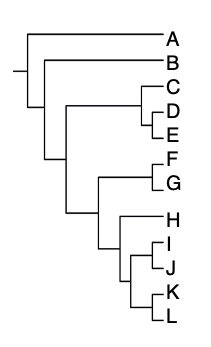
According to this phylogeny, species H shares more derived traits with which of these groups?
\
A. F & G
B. I & J
C. K & L
D. I & J & K & L
E. equally with F-L
\
A. F & G
B. I & J
C. K & L
D. I & J & K & L
E. equally with F-L
D
52
New cards
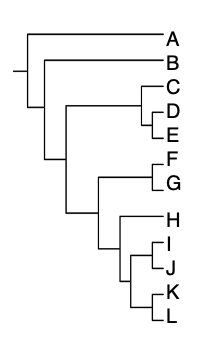
Which of the following sets of species consists of a monophyletic group? (also known as a clade)
\
A. A-E (A through E)
B. B-L
C. C-G
D. H and I
E. H-J
\
A. A-E (A through E)
B. B-L
C. C-G
D. H and I
E. H-J
B
53
New cards
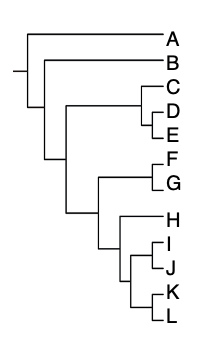
A biologist is studying phylogenetic relationships among __these species, C-L__ (C through L). In order to best determine which traits are ancestral vs. derived she should use *which of these* as the outgroup?
\
A. B
B. C
C. L
D. any species within her study group C-L
\
A. B
B. C
C. L
D. any species within her study group C-L
A
54
New cards
In a phylogenetic tree of species the term “sister taxa” refers to any two species
A. with the most shared, derived traits
B. that evolved from the most ancient common ancestor
C. that belong to the same large monophyletic group
D. that have the same function in the ecosystem
E. that currently live in the same geographic region
A. with the most shared, derived traits
B. that evolved from the most ancient common ancestor
C. that belong to the same large monophyletic group
D. that have the same function in the ecosystem
E. that currently live in the same geographic region
A
55
New cards
Biologists now routinely test for homology between __genes__ in different species. If genes are determined to be homologous, how are they related to each other?
A. by chance mutations
B. in function but not structure
C. because of convergent evolution
D. by descent from a common ancestor
A. by chance mutations
B. in function but not structure
C. because of convergent evolution
D. by descent from a common ancestor
D
56
New cards
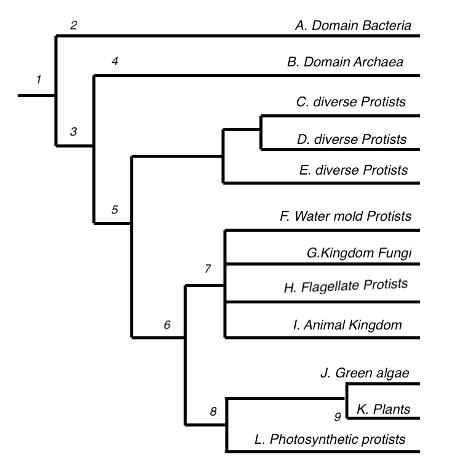
According to this phylogeny, what number represents the relative time when peptidoglycan cell walls evolved?
A. 1
B. 2
C. 3
D. 4
E. 5
A. 1
B. 2
C. 3
D. 4
E. 5
B
57
New cards
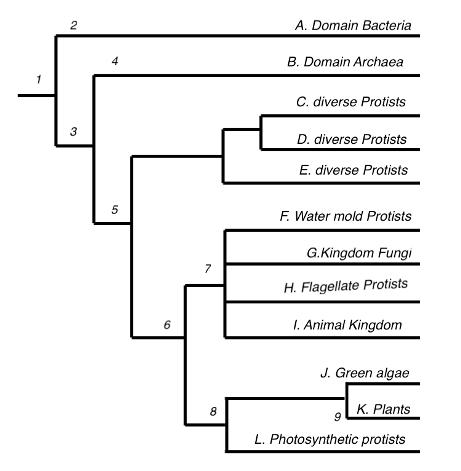
According to this phylogeny, what number represents the relative time when eukaryotic cell structure evolved?
\
A. 2
B. 3
C.4
D. 5
E. 6
\
A. 2
B. 3
C.4
D. 5
E. 6
D
58
New cards
Which one of these groups of the domain Archaea lives in a variety of environments on earth, not just extreme conditions where only highly adapted cells can live?
A. halophilic, salt-loving
B. thermophilic, heat-loving
C. methane-generating
A. halophilic, salt-loving
B. thermophilic, heat-loving
C. methane-generating
C
59
New cards
Which of these traits are shared by cells of all organisms? \n
A. use ATP as energy currency
B. genome of DNA
C. cell walls present
D. two of these are true for all
E. all three of these are true for all
A. use ATP as energy currency
B. genome of DNA
C. cell walls present
D. two of these are true for all
E. all three of these are true for all
D
60
New cards
The origin and ecological success of which group led to the earth’s change called the “oxygen revolution”?
A. Plants
B. Archaea
C. Animals
D. Cyanobacteria
A. Plants
B. Archaea
C. Animals
D. Cyanobacteria
D
61
New cards
Which traits are true for chemoheterotrophs?
A. energy from light, carbon from CO2
B. energy from inorganic chemicals, carbon from CO2
C. energy from light, carbon source is organic compounds
D. energy from organic compounds; carbon source is organic compounds
A. energy from light, carbon from CO2
B. energy from inorganic chemicals, carbon from CO2
C. energy from light, carbon source is organic compounds
D. energy from organic compounds; carbon source is organic compounds
D
62
New cards
Which of the following describes the nutritional mode of plants?
A. photoautotroph
B. chemoautotroph
C. photoheterotroph
D. chemoheterotroph
A. photoautotroph
B. chemoautotroph
C. photoheterotroph
D. chemoheterotroph
A
63
New cards
Which of the following describes the nutritional mode of animals?
A. photoautotroph
B. chemoautotroph
C. photoheterotroph
D. chemoheterotroph
A. photoautotroph
B. chemoautotroph
C. photoheterotroph
D. chemoheterotroph
D
64
New cards
Which of these is a chemical process accomplished only by certain Bacteria and no other organisms?
A. cellular respiration
B. photosynthesis
C. nitrogen fixation
D. methane production
A. cellular respiration
B. photosynthesis
C. nitrogen fixation
D. methane production
C
65
New cards
A history of endosymbiosis explains the __evolutionary origin__ of
A. Bacteria
B. Chloroplasts
C. Mitochondria
D. two of the above
E. all three of the above
A. Bacteria
B. Chloroplasts
C. Mitochondria
D. two of the above
E. all three of the above
D
66
New cards
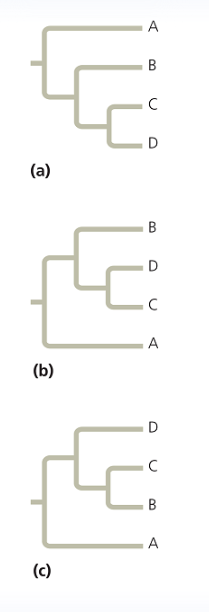
Which of the trees shown here depicts an evolutionary history different from the other two? Why?
\
A. (a) because it lists the letters in order from top to bottom, unlike the other two trees
B. (b) because the letters are not in sequence, unlike the other two trees
C. (c) because sister taxa are C and D unlike the other two trees
\
A. (a) because it lists the letters in order from top to bottom, unlike the other two trees
B. (b) because the letters are not in sequence, unlike the other two trees
C. (c) because sister taxa are C and D unlike the other two trees
C
67
New cards
Which of the following is NOT specific information supporting the endosymbiosis hypothesis for the origin of mitochondria from a prokaryotic ancestor?
A. Mitochondria can replicate by binary fission
B. Mitochondria have one loop chromosome
C. Mitochondria are about the same size as bacteria
D. Mitochondria have prokaryotic-type ribosomes
E. Mitochondria have a double membrane
A. Mitochondria can replicate by binary fission
B. Mitochondria have one loop chromosome
C. Mitochondria are about the same size as bacteria
D. Mitochondria have prokaryotic-type ribosomes
E. Mitochondria have a double membrane
C
68
New cards
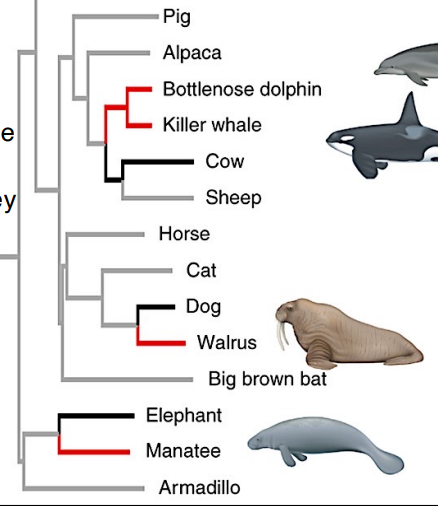
The *similarity* of manatee and dolphin *body form* is because they are what kind of traits?
\
A. Analogous
B. Homologous
C. Ancestral
D. Derived
\
A. Analogous
B. Homologous
C. Ancestral
D. Derived
A
69
New cards
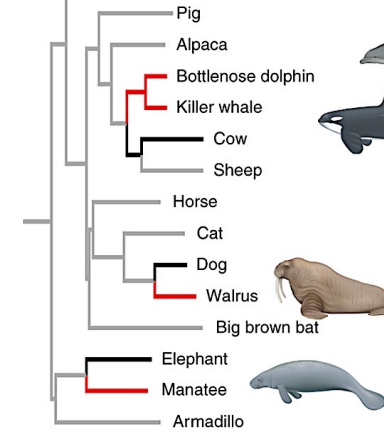
According to this phylogeny, which of these sets is a monophyletic group?
\
A. cat, dog, walrus
B. pig, cow, sheet
C. horse, cat, dog
D. horse, cow, sheep
\
A. cat, dog, walrus
B. pig, cow, sheet
C. horse, cat, dog
D. horse, cow, sheep
A
70
New cards
The Australian marsupial mole and the North American mole have similar body form, forelegs with claws specialized for digging and a snout for poking in the ground.
Which of these is the most likely explanation of their similar body structures?
\
A. They share a widespread, recent common ancestor with all of these traits
B. They live in similar habitats and have similar behavior. Individuals acquired these structures as they dug for food and shelter
C. They live in similar habitats and have similar behavior. Individuals with these traits had greater reproductive fitness so passed on their genes.
Which of these is the most likely explanation of their similar body structures?
\
A. They share a widespread, recent common ancestor with all of these traits
B. They live in similar habitats and have similar behavior. Individuals acquired these structures as they dug for food and shelter
C. They live in similar habitats and have similar behavior. Individuals with these traits had greater reproductive fitness so passed on their genes.
C
71
New cards
Which of these describes all members of the “kingdom” Protista?
A. multicellular prokaryotes
B. multicellular eukaryotes
C. unicellular prokaryotes (can exist as clusters of unspecialized cells)
D. unicellular eukaryotes (can exist as clusters of unspecialized cells)
A. multicellular prokaryotes
B. multicellular eukaryotes
C. unicellular prokaryotes (can exist as clusters of unspecialized cells)
D. unicellular eukaryotes (can exist as clusters of unspecialized cells)
D
72
New cards
Which of these features of all members of the Animal Kingdom distinguish them from other kingdoms or domains?
A. Cell-cell communication systems are present
B. Different cells in the body are specialized for specific functions
C. Cells are attached to each other to make a multicellular organism
D. Embryos have layers of cells that will develop into specific tissues and organs
E. more than one of these is true
A. Cell-cell communication systems are present
B. Different cells in the body are specialized for specific functions
C. Cells are attached to each other to make a multicellular organism
D. Embryos have layers of cells that will develop into specific tissues and organs
E. more than one of these is true
D
73
New cards
What is a feature of Plants that is NOT found in either Animals or Fungi?
\
A. they are autotrophs
B. their cells have cell walls
C. their cells have mitochondria
D. they have multicellular reproductive organs
E. more than one of these is true and a distinction
\
A. they are autotrophs
B. their cells have cell walls
C. their cells have mitochondria
D. they have multicellular reproductive organs
E. more than one of these is true and a distinction
A
74
New cards
In a group of related fungi, some species reproduce only asexually. Which of the following ways to determine whether or not two groups are distinct species would NOT be useful?
\
A. cell shape and structure
B. DNA sequences
C. biological species definition
D. chromosome movement patterns during mitosis
E. which specific antibiotics they produce
\
A. cell shape and structure
B. DNA sequences
C. biological species definition
D. chromosome movement patterns during mitosis
E. which specific antibiotics they produce
C
75
New cards
Which of the following is a distinguishing trait of __all__ true animals?
A. circulatory system
B. a head or cranium
C. segments and appendages
D. embryonic cell layers
A. circulatory system
B. a head or cranium
C. segments and appendages
D. embryonic cell layers
D
76
New cards
Which of the following is the set of taxa (vertebrate classes) that have amniotic eggs?
A. Amphibia, Bony Fish, and Reptiles
B. Birds, Mammals, and Reptiles
C. Birds and Reptiles
D. Amphibia, Birds, Mammals and Reptiles
E. All classes of vertebrates including fish
A. Amphibia, Bony Fish, and Reptiles
B. Birds, Mammals, and Reptiles
C. Birds and Reptiles
D. Amphibia, Birds, Mammals and Reptiles
E. All classes of vertebrates including fish
B
77
New cards
Researchers suggest that the evolutionary increase in the number of *hox* genes
A. led to reproductive isolation in all cases
B. could explain the evolution of color vision
C. allowed for the evolution of more complex body patterns
D. resulted in a decrease in the number of body segments in insects
E. resulted in all of the above
A. led to reproductive isolation in all cases
B. could explain the evolution of color vision
C. allowed for the evolution of more complex body patterns
D. resulted in a decrease in the number of body segments in insects
E. resulted in all of the above
C
78
New cards
The crustacean *Daphnia* (”water flea”) reproduces clonally for some of the year (many small eggs, by mitosis) and then (when?) produces eggs by meiosis, mates and produces a few larger offspring. Is the sexual reproduction stage at the very *beginning* of summer or at the *end* of summer?
\
A. at the beginning of summer because growth conditions are optimal
B. at the beginning of summer because more offspring can be produced
C. at the end of summer because conditions are changing
D. at the end of summer because it’s easier for them to find mates in cooler weather
\
A. at the beginning of summer because growth conditions are optimal
B. at the beginning of summer because more offspring can be produced
C. at the end of summer because conditions are changing
D. at the end of summer because it’s easier for them to find mates in cooler weather
C
79
New cards
The earliest animals evolved from which type of non-animal ancestors?
A. Bacteria
B. Archaea
C. Protists
D. Fungi
A. Bacteria
B. Archaea
C. Protists
D. Fungi
C
80
New cards
A waxy cuticle is an adaptation that
\
A. helps prevent water loss in algae
B. aids in transport of water in plants
C. aids intake of carbon dioxide in algae
D. aids intake of carbon dioxide in plants
E. reduces evaporation from surface of plants
\
A. helps prevent water loss in algae
B. aids in transport of water in plants
C. aids intake of carbon dioxide in algae
D. aids intake of carbon dioxide in plants
E. reduces evaporation from surface of plants
E
81
New cards
Which of the following caused the “oxygen revolution”?
A. release of gases from the cooling earth
B. evolutionary origin of aerobic respiration
C. success of photosynthetic bacteria
D. success of photosynthetic plants
A. release of gases from the cooling earth
B. evolutionary origin of aerobic respiration
C. success of photosynthetic bacteria
D. success of photosynthetic plants
C
82
New cards
Genes for ribosomal RNA (rRNA) are found in the genomes of all organisms. A comparison of rRNA sequences in flowering plant chloroplast genomes would show them closest to which of these?
A. rRNA sequences in plant nuclear genomes
B. rRNA sequences in archaeal genomes
C. rRNA sequences in bacterial genomes
D. rRNA sequences in animal nuclear genomes
E. rRNA sequences in fungi nuclear genomes
A. rRNA sequences in plant nuclear genomes
B. rRNA sequences in archaeal genomes
C. rRNA sequences in bacterial genomes
D. rRNA sequences in animal nuclear genomes
E. rRNA sequences in fungi nuclear genomes
C
83
New cards
Of the following groups, the closest relatives of fungi are thought to be the
\
A. animals
B. vascular plants
C. mosses
D. slime molds
\
A. animals
B. vascular plants
C. mosses
D. slime molds
A
84
New cards
Specific environmental changes that are associated with the burst of animal diversity known as the Cambrian explosion are:
A. higher oxygen levels
B. cooler global temperatures
C. higher dissolved minerals in sea water
D. two of these
E. all three of these
A. higher oxygen levels
B. cooler global temperatures
C. higher dissolved minerals in sea water
D. two of these
E. all three of these
D
85
New cards
Which of the following was probably the LEAST important factor in bringing about the Cambrian explosion of animal diversity? \n \[similar topic in previous question; both from old exams\]
\
A. the emergence of predator-prey relationships
B. an increase in the concentration of atmospheric oxygen
C. availability of calcium and phosphates in sea water
D. movement of animals onto land
E. the origin of hox genes
\
A. the emergence of predator-prey relationships
B. an increase in the concentration of atmospheric oxygen
C. availability of calcium and phosphates in sea water
D. movement of animals onto land
E. the origin of hox genes
D
86
New cards
In a phylogenetic study of just birds and reptiles, the condition of all of them having four limbs (tetrapod) is
A. a shared ancestral character
B. a shared derived character;
C. a character useful for distinguishing birds from mammals
D. an example of analogy rather than homology.
A. a shared ancestral character
B. a shared derived character;
C. a character useful for distinguishing birds from mammals
D. an example of analogy rather than homology.
A
87
New cards
Which one of the following is among the evolutionary *advantages* (benefits) of multicellular, instead of unicellular, structure?
A cell-cell communication systems are required
B. less energy is required overall for maintenance of the whole organism
C. if a few cells are injured the entire organism is likely to die
D. multicellular organisms, and not unicellular ones, can have sexual reproduction
E. cells can specialize and have division of labor.
A cell-cell communication systems are required
B. less energy is required overall for maintenance of the whole organism
C. if a few cells are injured the entire organism is likely to die
D. multicellular organisms, and not unicellular ones, can have sexual reproduction
E. cells can specialize and have division of labor.
E
88
New cards
Which of these is the most accurate description of phototropism?
A. Plant shoot bends towards the light
B. Plant shoot grows towards the light.
C. Plant shoot bends away from gravity.
D. Plant shoot grows away from gravity.
A. Plant shoot bends towards the light
B. Plant shoot grows towards the light.
C. Plant shoot bends away from gravity.
D. Plant shoot grows away from gravity.
B
89
New cards
How is the hormone auxin involved in phototropism?
A. Auxin can trigger cells to change shape and bend.
B. Auxin can trigger cells to elongate.
C. Cells without auxin receptors change shape and bend when auxin is present
D. Cells without auxin receptors elongate when auxin is present
E. Two of these statements are true
A. Auxin can trigger cells to change shape and bend.
B. Auxin can trigger cells to elongate.
C. Cells without auxin receptors change shape and bend when auxin is present
D. Cells without auxin receptors elongate when auxin is present
E. Two of these statements are true
B
90
New cards
Which is a statement of null hypothesis concerning auxin signaling and phototropism?
A. Auxin is the cause of phototropism
B. If there is no auxin, there is no phototropism.
C. If there is no auxin receptor, there will be no phototropism
D. There is no relationship between auxin and phototropism
E. More than one of these is a null hypothesis statement.
A. Auxin is the cause of phototropism
B. If there is no auxin, there is no phototropism.
C. If there is no auxin receptor, there will be no phototropism
D. There is no relationship between auxin and phototropism
E. More than one of these is a null hypothesis statement.
D
91
New cards
In a certain experiment, the hypothesis statement is: “As a result of auxin binding to its membrane receptor, the cell elongates.”
Which of these is the __dependent__ variable?
A. The presence of auxin
B. The presence of auxin receptor
C. The presence of the cell membrane
D. The elongation of the cell
Which of these is the __dependent__ variable?
A. The presence of auxin
B. The presence of auxin receptor
C. The presence of the cell membrane
D. The elongation of the cell
D
92
New cards
Which of the following best describes plant meristems?
A. continuous growth by cell elongation
B. growth mainly in embryo plant;
C. continuous mitosis of specialized cells
D. continuous mitosis of undifferentiated cells
A. continuous growth by cell elongation
B. growth mainly in embryo plant;
C. continuous mitosis of specialized cells
D. continuous mitosis of undifferentiated cells
D
93
New cards
Which of the following bests describes plasmodesmata?
A. holes in the cell walls of adjacent plant cell
B. aligned ion channels in the membranes of adjacent cells
C. tubes of cytoplasm connecting one cell to adjacent cell
D. bundles of cellulose connecting adjacent cells
A. holes in the cell walls of adjacent plant cell
B. aligned ion channels in the membranes of adjacent cells
C. tubes of cytoplasm connecting one cell to adjacent cell
D. bundles of cellulose connecting adjacent cells
C
94
New cards
In order to be a __target cell__ for a particular animal hormone signal, the cell must:
A. Be able to produce that hormone
B. Be very close to the cells that produce that hormone
C. Have a specific receptor for that hormone
D. Two of these are true
A. Be able to produce that hormone
B. Be very close to the cells that produce that hormone
C. Have a specific receptor for that hormone
D. Two of these are true
C
95
New cards
Which of these explains how a response to auxin leads to cell elongation?
A. stretches the cellulose fibers in the cell wall so cell expands uniformly
B. loosens connections between cellulose fibers so water can enter the cell
C. lower pH creates gaps between cells to elongate the tip
D. auxin enters cell and promotes water uptake
A. stretches the cellulose fibers in the cell wall so cell expands uniformly
B. loosens connections between cellulose fibers so water can enter the cell
C. lower pH creates gaps between cells to elongate the tip
D. auxin enters cell and promotes water uptake
B
96
New cards
Which of the following is good match between a challenge of living on land (first) and a solution for it (second) that evolved in the plant kingdom?
A. evaporation of water – abundant leaf pores
B. lack of water’s buoyancy & support – roots
C. competition to absorb light – taller stems
D. transport water from roots to leaves - waxy cuticle
A. evaporation of water – abundant leaf pores
B. lack of water’s buoyancy & support – roots
C. competition to absorb light – taller stems
D. transport water from roots to leaves - waxy cuticle
C
97
New cards
Into which of these cells would water tend to move?
\
A. Into a cell with more solutes
B. Into a cell with higher fluid pressure
C. Into neither of these
D. Into both (either) of these
\
A. Into a cell with more solutes
B. Into a cell with higher fluid pressure
C. Into neither of these
D. Into both (either) of these
A
98
New cards
Water will tend to move __into__ a plant cell that has what combination of conditions?
A. lower solute concentration and higher fluid pressure;
B. lower solute concentration and lower fluid pressure;
C. higher solute concentration and higher fluid pressure;
D. higher solute concentration and lower fluid pressure
A. lower solute concentration and higher fluid pressure;
B. lower solute concentration and lower fluid pressure;
C. higher solute concentration and higher fluid pressure;
D. higher solute concentration and lower fluid pressure
D
99
New cards
The action of proton pumps in root hairs (and most everywhere in plants) is to
A. Transport H+ ions out of the cell by passive facilitated diffusion
B. Transport H+ ions into the cell by passive facilitated diffusion
C. Transport H+ ions out of the cell by using ATP
D. Transport H+ ions into the cell by using ATP
A. Transport H+ ions out of the cell by passive facilitated diffusion
B. Transport H+ ions into the cell by passive facilitated diffusion
C. Transport H+ ions out of the cell by using ATP
D. Transport H+ ions into the cell by using ATP
C
100
New cards
After proton pump action has created an electrical gradient, then __in response to that electrical gradient alone__ (no more ATP spent) what can happen?
\
A. Cations like K+ can enter the cell passively
B. Anions like NO3- can enter the cell passively
C. Water can enter the cell passively.
D. Two of these (A, B, C) are true
E. All of these (A, B, and C)
\
A. Cations like K+ can enter the cell passively
B. Anions like NO3- can enter the cell passively
C. Water can enter the cell passively.
D. Two of these (A, B, C) are true
E. All of these (A, B, and C)
A